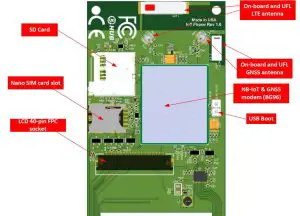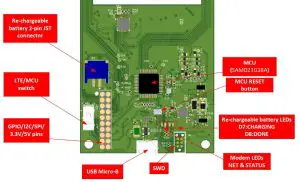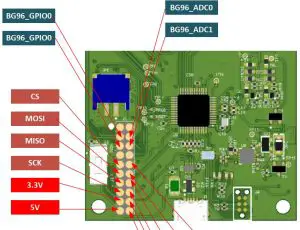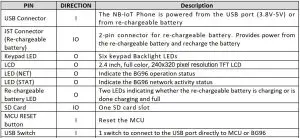5GHUB NB-IoT & GNSS Phone BG96 User Manual
Purpose of the DocumentThe purpose of this document is to explain the technical specifications and manual for using the NB-IoT & GNSS Phone.
Document History
1. Package contents:
NB-IoT & GNSS Phone Package
- NB-IoT & GNSS modem with full-color LCD, keypad, re-chargeable battery, SD card in a phone-like shape.
Download
Arduino software can be downloaded from the following website:https://github.com/5ghub/5G-NB-IoT/tree/master/KitSketches
To use the NB-IoT phone with Arduino IDE and starts running Arduino projects and sketches, install the following software:
Install Arduino IDE for Windows from the following websitehttps://www.arduino.cc/en/Main/Software
Download and Install LTE&GNSS modem driver for Windows OS:https://github.com/5ghub/5G-NB-IoT/tree/master/Driver
Download and Install QNavigator &QCOM tools for Quectel BG96 here:https://github.com/5ghub/5G-NB-IoT/tree/master/Tools
Download and install Arduino library (5G-NB-IoT_Arduino.zip) here:https://github.com/5ghub/5G-NB-IoT
All the following software can be installed from the GitHub location here:https://github.com/5ghub/5G-NB-IoT
The NB-IoT phone Arduino sketches are in this folder:https://github.com/5ghub/5G-NB-IoT/tree/master/NBIoTPhone
LTE cellular connectivity on Windows OS
2. General Description
Overview
The NB-IoT & GNSS IoT phone is like a real phone. It is a cellular NB-IoT and GPS device that can be used for the 5G wireless technology. The phone has a keypad and full-color TFT LCD display with LTE & GNSS antenna connectors (or on-board antennas). The phone is a powerful board that features a microcontroller, wireless modem, keypad, a full-color TFT LCD, re-chargeable battery, and SD card. The microcontroller is an Atmel’s SAMD21G18A MCU which features a 32-bit ARM Cortex® M0+ core. The wireless modem is BG96 which is an embedded IoT (LTE Cat-M1, LTE Cat-NB1 and EGPRS) wireless communication module. BG96 wireless modem provides a maximum data rate of 375Kbps downlink and 375Kbps uplink. It features ultra-low power consumption, provides data connectivity on LTE-TDD/ LTE-FDD/GPRS/EDGE networks, and supports half-duplex operation in LTE networks. It also provides GNSS to meet customers’ specific application demands.
The LCD is a full-color, 2.4 inch with 240×320 pixel resolution. The Keypad consist of 25 keys covering numbers, alphabets, characters, Up/Down/Right/Left buttons, and functions buttons. The IoT phone can be powered from either a UCB power source or a re-chargeable battery.
The IoT phone provides rich sets of Internet protocols, industry-standard interfaces (USB/UART/I2C/Status Indicator) and abundant functionalities. The board offer a high integration level and enables integrators and developers to easily design their applications and take advantage of the board low power consumption, many functionalities, and USB drivers for Windows 7/8/8.1/10, Linux and Android.
The NB-IoT phone mimics real cellular phone and is a rich hardware board that can be used for the latest 5G wireless technology and enables a variety of smart and 5G applications for devices, and acts as a great educational tool for learning about 5G and 32-bit application development. It enables large number of applications such as wireless POS, smart metering, tracking, smart transportation, smart buildings, smart city, and smart homes.
The NB-IoT phone is also compatible with Arduino and Arduino software (IDE). Arduino sketches and examples are provided with the kit and additional sketches can be developed and uploaded to the board.
Key Features
- Atmel ATSAMD21G18 MCU
- Quectel BG96 NB-IoT module
- Full-color, 2.4 inch with 240×320 pixel resolution LCD
- 25-buttons keypad with backlight LEDs
- SD Card slot
- Can be powered and charging a re-chargeable battery
- Supports LTE NB-IoT and Machine Type Communications (MTC)
- Supports EGPRS
- Global Frequency Band B1/B2/B3/B4/B5/B8/B12/B13/B18/B19/B20/B26/B28/B39 (B39 for Cat.M1 only) for LTE and 850/900/1800/1900MHz for EGPRS
- Supports the protocols TCP/UDP/PPP/ SSL/ TLS/ FTP(S)/ HTTP(S)/ NITZ/ PING/ MQTT
- Supports SMS
- Supports GNSS technology (GPS, GLONASS, BeiDou/Compass, Galileo, QZSS)
- Compact board size of 65 mm x 30mm
- Nano USIM card slot
- Arduino IDE Compatible
- Works with Windows, Linux, or Android
- Ready for smart applications and development (smart home, smart city, smart transportation, smart metering, smart farming, smart waste management, asset tracking, location, navigation, mapping, and timing applications). Application such as Gas Detector, Soil PH Tester, Optical Sensor, Machinery Alarm System, Irrigation Controller, Elevator, Asset Tracking Electronics, Person/Pet Tracking, Water/Gas Metering, Smart Parking System, Fire Hydrant, Smoke Alarm, Trash Bin, Street Lighting
- The board can be powered via the USB connector
- Each of the 14 general purpose I/O pins on the board can be used for digital input or digital output using pinMode(), digitalWrite(), and digitalRead() functions. Pins used for PWM can be using analogWrite() function. All pins operate at 3.3 volts. Each pin can source or sink a maximum of 10 mA and has an internal pull-up resistor (disconnected by default) of 20-60 K ohm.
Overview Diagrams
Figure 1. NB-IoT Phone Overview Diagram – Top & Bottom Views
Figure 2. NB-IoT Phone Top View – LCD is ON
Physical Characteristics
The width and length of the IoT phone is 64 mm (width) by 123 mm (length). The board have four screw holes in each corner that allows the board to be attached to a surface or case.
Figure 3. Physical Characteristics.
Peripherals – Key Components
Figure 4. NB-IoT Phone Top Side – Key Components


Figure 5. NB-IoT Phone Bottom Side – Key Components
Peripherals – IO Connections


Figure 6. NB-IoT Phone Connectors
* I2C interface lines might be configured as USART interface SDA line can work then as USART TXD and SCL line can work as USART RXD)
** MOSI and SCK lines might be configured as USART interface (MOSI line can work then as USART TXD and SCK line can work as USART RXD)
Hardware Specification



Notes:
- UART can be programmed through any of general-purpose pins.
- SPI can be programmed through any of general-purpose pins.
PIN Description




PrecautionThe NB-IoT phone runs at 3.3V. The maximum voltage that the I/O pins can tolerate is 3.3V. Applying voltages higher than 3.3V to any I/O pin could damage the board
BG96 chipset
All functionality of the BG96 shipset shall be implemented excluding the following features. That is, the following features are not supported [1][2].
- Audio, Earphone, and Codes are not supported.
- PCM and I2C are not supported
- PSM_IND and AP_READY are not supported
Interface between SAM21D and BG96
The Microcontroller communicates with the BG96 through UART interfaces:
- UART1: (PA12/PA13/PA14/PA15). Used for data transmission and AT command communication 115200bps by default. The default frame format is 8N1 (8 data bits, noparity, 1 stop bit) Support RTS and CTS hardware flow control.
- UART3: (PB23/PB22). Used for outputting GNSS data or NEMA sentences 115200bps baud rate.
3. References
[1] Quectel_BG96_Hardware_Design_V1.2.pdf[2] Quectel_BG96_Reference_Design_Rev.A_20170814.pdf[3] Quectel_Antenna_Design_Note_V2.0.pdf[4] Quectel_RF_Layout_Application_Note_V2.2.pdf[5] Quectel_QFlash_User_Guide_V2.3[6] Arduino IDE, https://www.arduino.cc/en/Main/Software[7] Arduino IDE, https://www.arduino.cc/en/Guide/ArduinoZero[8] Microchip, “Low-Power, 32-bit Cortex-M0+ MCU with Advanced Analog and PWM”
References
GitHub – 5ghub/5G-NB-IoT
5G-NB-IoT/Driver at master · 5ghub/5G-NB-IoT · GitHub
Getting started with the Arduino Zero | Arduino
Home – 5G HUB TECHNOLOGIES, INC
Software | Arduino
5G-NB-IoT/Tools at master · 5ghub/5G-NB-IoT · GitHub
5G-NB-IoT/NBIoTPhone at master · 5ghub/5G-NB-IoT · GitHub
5G-NB-IoT/KitSketches at master · 5ghub/5G-NB-IoT · GitHub
[xyz-ips snippet=”download-snippet”]
